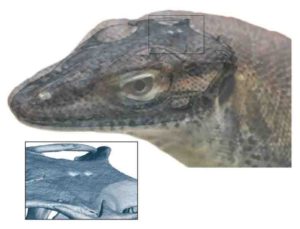
Researchers reporting in Current Biology on April 2 have evidence that an extinct species of monitor lizard had four eyes, a first among known jawed vertebrates. Today, only the jawless lampreys have four eyes.
The third and fourth eyes refer to pineal and parapineal organs, eye-like photosensory structures on the top of the head that play key roles in orientation and in circadian and annual cycles. The new findings help to elucidate the evolutionary history of these structures among vertebrates.
The photosensitive pineal organ is found in a number of lower vertebrates such as fishes and frogs, the researchers explain. It’s often referred to as the “third eye” and was widespread in primitive vertebrates.
“On the one hand, there was this idea that the third eye was simply reduced independently in many different vertebrate groups such as mammals and birds and is retained only in lizards among fully land-dwelling vertebrates,” says Krister Smith at the Senckenberg Research Institute in Germany. “On the other hand, there was this idea that the lizard third eye developed from a different organ, called the parapineal, which is well developed in lampreys. These two ideas didn’t really cohere.
“By discovering a four-eyed lizard — in which both pineal and parapineal organs formed an eye on the top of the head — we could confirm that the lizard third eye really is different from the third eye of other jawed vertebrates,” Smith continues.
Smith and his colleagues got the idea that the fossilized lizards might have a fourth eye after other experts came to contradictory conclusions about where the lizard’s third eye was located.
Smith said that the first question to explore the “wacky” idea of a lizard with four eyes was, does this unusual feature occur in more than one individual of the same age? They turned to museum specimens collected nearly 150 years ago at Grizzly Buttes as part of the Yale College Expedition to the Bridger Basin, Wyoming. And, it turned out that the answer to their question was yes. CT scans showed that two different individuals had spaces where a fourth eye would have been, which, Smith says, “I certainly did not expect!”
Their evidence confirms that the pineal and parapineal glands weren’t a pair of organs in the way that vertebrate eyes are. They also suggest that the third eye of lizards evolved independently of the third eye in other vertebrate groups.
Smith says that while there’s “nothing mystical” about the pineal and parapineal organs, they do enable extraordinary abilities. For instance, they allow some lower vertebrates to sense the polarization of light and use that information to orient themselves geographically.
Scientists still have a lot to learn about the evolution of these organs and their functions in living animals, the researchers say. The new findings are a reminder of the hidden value within fossils left lying around in museums for more than a century.
“The fossils that we studied were collected in 1871, and they are quite scrappy — really banged up,” Smith says. “One would be forgiven for looking at them and thinking that they must be useless. Our work shows that even small, fragmentary fossils can be enormously useful.”
Reference:
Krister T. Smith, Bhart-Anjan S. Bhullar, Gunther Köhler, Jörg Habersetzer. The Only Known Jawed Vertebrate with Four Eyes and the Bauplan of the Pineal Complex. Current Biology, 2018; 28 (7): 1101 DOI: 10.1016/j.cub.2018.02.021
Note: The above post is reprinted from materials provided by Cell Press.










